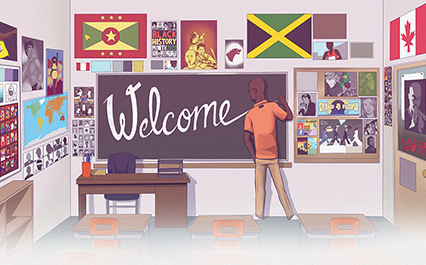Page Content

My class and its decor aim to show my students multiple paths by multiple people so that they can believe that they can do multiple things.
MY CLASSROOM REPRESENTS ME IN MANY WAYS, but it also represents what I hope my students would hope to see in my classes: themselves.
When I was growing up, all of the pictures of historians or authors in my classes didn’t look like me, yet their faces were on the walls of my classes. Every time I looked in the rooms, I always wondered, “Is there a place for me? Or someone like me?” Maybe one day.
That one day came in 2014 when I graduated from the University of Alberta with an after degree in education. And I greatly wanted to change my room to what I always wanted to see, but being on a temporary contract, you have to pick your battles, especially if you can’t really pick your own home room.
When I finally got settled into my own home room, I hung a poster of my favourite poet. His name wasn’t Shakespeare; his name was Tupac Shakur. His poster hangs just outside my main window, his hands in a gesture of prayer. I’m a big fan of Marvel movies, so I put up posters of comic books and my favourite Marvel movie: The Black Panther. I placed that poster on my front door.
But what really stands out in my room are the collages of faces. One wall represents Asian communities. Another, First Nation, Métis and Inuit brothers and sisters. Another wall, heroes from the Pride community. Another wall is committed to Arab Muslim communities. Finally, the left corner of my back wall is a tribute to Black history and Canadian icons, not just politicians, rulers or monarchs, but good people who truly represent our nation and its core values. I structured the photos to resemble a crowded train station. Everyone is different, everyone is important, everyone is present.
Also, as a tribute to my love of sports, I put up various pictures of athletes from all communities, including paralympians, female athletes, Muslim athletes and athletes who were also champions of social justice.
A colleague once said to me that too many visuals in a room is a distraction, and I agree it can be, but what if these pictures weren’t distractions, but motivational tools? Imagine if, every time you walked into a class, you saw yourself or someone who looked like you. Subconsciously, it could mean that you could also be on a wall one day—as a politician, athlete, artist, musician, educator, Nobel peace prize winner, activist or leader?
Displaying authentic representations of diversity makes students feel included, supported, loved, appreciated, but most of all welcomed into your classroom.
You can be Sacheen Littlefeather or Ashley Callingbull. You can be George Takei or Chow Yun-Fat. You can be Dr. Martin Luther King Jr. or Mahatma Gandhi. You can be RuPaul or Harvey Milk. You can be Rosa Parks or Viola Desmond. You can be Mahershala Ali or Muhammad Ali. You can be anything. The faces in the room confirm and affirm this. Every time you come to class.
When we aren’t represented, it’s hard to carve a path. It’s not impossible, but it’s hard. My class and its decor aim to show my students multiple paths by multiple people so that they can believe that they can do multiple things. In our schools, and in their lives.
